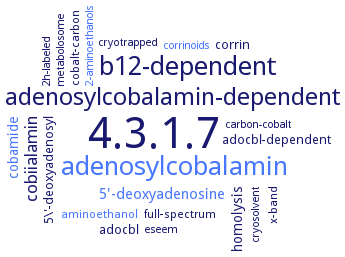4.3.1.7: ethanolamine ammonia-lyase
This is an abbreviated version!
For detailed information about ethanolamine ammonia-lyase, go to the full flat file.

Word Map on EC 4.3.1.7 
-
4.3.1.7
-
b12-dependent
-
adenosylcobalamin
-
adenosylcobalamin-dependent
-
cobiialamin
-
5'-deoxyadenosine
-
homolysis
-
cobamide
-
corrin
-
5\'-deoxyadenosyl
-
adocbl
-
adocbl-dependent
-
cobalt-carbon
-
aminoethanol
-
x-band
-
full-spectrum
-
metabolosome
-
2h-labeled
-
carbon-cobalt
-
cryotrapped
-
cryosolvent
-
2-aminoethanols
-
corrinoids
-
eseem
- 4.3.1.7
-
b12-dependent
- adenosylcobalamin
-
adenosylcobalamin-dependent
-
cobiialamin
- 5'-deoxyadenosine
-
homolysis
- cobamide
-
corrin
-
5\'-deoxyadenosyl
-
adocbl
-
adocbl-dependent
-
cobalt-carbon
- aminoethanol
-
x-band
-
full-spectrum
-
metabolosome
-
2h-labeled
-
carbon-cobalt
-
cryotrapped
-
cryosolvent
- 2-aminoethanols
- corrinoids
-
eseem
Reaction
Synonyms
AEL, ammonia-lyase, ethanolamine, EAL, ethanolamine ammonia lyase, ethanolamine ammonia-lyase, ethanolamine ammonia-lyase BMC, ethanolamine deaminase, ethanolamine-ammonia lyase, eut-L, EutB, eutBC
ECTree
Advanced search results
Inhibitors
Inhibitors on EC 4.3.1.7 - ethanolamine ammonia-lyase
Please wait a moment until all data is loaded. This message will disappear when all data is loaded.
(S)-1-amino-2-propanol
-
inactive substrate analogue
adenosylmethylcobalamin
-
0.1% coenzyme activity compared to adenosylcobalamin, holoenzyme with adenosylmethylcobalamin undergoes rapid inactivation
hydroxyethylhydrazine
-
the latter suicide inhibitor effects a stoichiometric conversion of enzyme-bound adenosylcobalamin into its cleaved form cob(II)alamin
p-hydroxymercuribenzoate
-
0.0001 mM, 50% inhibition; even in the presence of ethanolamine
additional information
-
the holoenzyme of adenosylcobalamin-dependent ethanolamine ammonia lyase undergoes suicidal inactivation during catalysis as well as inactivation in the absence of substrate. The inactivation involves the irreversible cleavage of the Co-C bond of the coenzyme. Inactivated holoenzyme undergoes rapid and continuous reactivation in the presence of ATP, Mg2+ and free adensosylcobalamin. EutA is essential for reactivation. Reactivation and activation occur through the exchange of modified coenzyme for free intact adenosylcobalamin
-


 results (
results ( results (
results ( top
top






